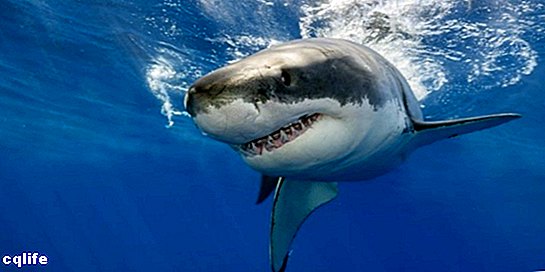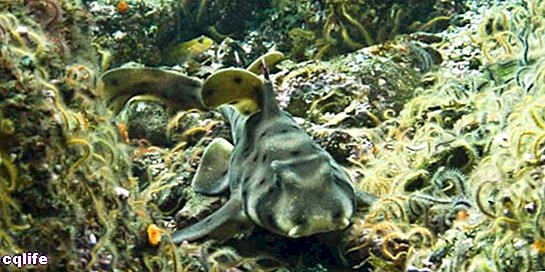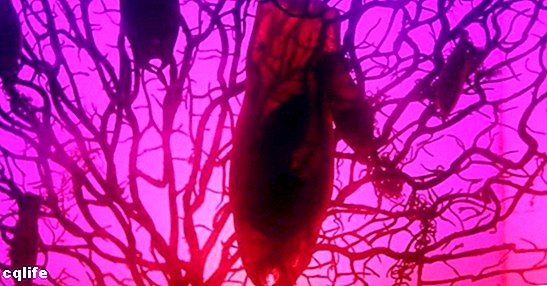- What are sharks?
- Shark characteristics
- Types of sharks
- Shark feeding
- Shark habitat
- Reproduction of sharks
- How do sharks sleep?
- Shark attacks
We explain what sharks are, what their diet, habitat, reproduction and other characteristics are like. Also, how they sleep.

What are sharks?
Sharks are a group of cartilaginous fish (that is, without a bony skeleton) popularly known as shark or shark and scientifically as selachymorphs or selacimorphs (that is, belonging to the superorder Selachimorph). It is one of the Marine animals most popular and feared by the humanity, due to its role as a fierce marine predator.
Sharks make up a very diverse group of animals, which includes large fish and others of small size, in fresh water or mainly in salt water, present in practically all the geographies of the world.
They arose evolutionarily at the same time as the stripes and chimeras, with whom they share the class Chondrichthyes, 400 million years ago, in the Devonian period. Since then they have evolved and changed to give rise to the 360 species of modern sharks, about 100 million years ago.
Despite their reputation as ferocious animals, many species of sharks are found today in Danger of extinction, due to selective hunting by the human being. They are fished for sport, or as a source of fins for certain gastronomic dishes, and formerly its rough skin was used as sandpaper.
Shark characteristics
In general, sharks are characterized by the following:
- They commonly occupy the role of predators in its various habitats.
- They are usually torpedo-shaped, with a powerful tail at the end and a set of three larger fins: dorsal (on the animal's back), and two pectorals (on the animal's chest). In addition, it has three other smaller fins: pelvic, anal and a second dorsal fin.
- Their bodies are made of cartilage, except for their powerful jaws, filled with serrated triangular teeth. The mouth is under the muzzle, arched and half open all the time, and the eyes are one on each side of the skull.
- They can be immense like the whale shark (18 meters in length) or small like the pygmy shark (which can fit in a human hand).
- They breathe through five to seven pairs of gills, located on the sides of the head. To do so they must be in continuous movement, so that the Water penetrate their mouths. Similarly, lacking a swim bladder, they must constantly swim or sink to the bottom of the seas.
- Its skin is usually rough, strong, made up of scales and designed to silence the movements of the animal, reducing the friction with the Water.
- The longevity of sharks does not exceed 30 years in most species, although a few can reach a hundred, thanks to the formidable immune system of the shark, which is subject to study by scientists.
Types of sharks

Heterodontiformes are used to nightlife and reefs.
Within the diversity of sharks there are various orders, which group species with similar characteristics. These are eight different orders, which are:
- Hexanchiform. In this order there are six living species grouped into three families, characterized by having six gills, a single dorsal fin and lacking a third eyelid. It is the most primitive order of existing sharks, such as the eel shark (Chlamydoselachus anguineus) or the cow shark (Notorynchus cepedianus).
- Squaliformes. In this order there are 125 living species, in seven different families, which also lack a third eyelid and in addition to an anal fin, but have two dorsal fins, some of which can be poisonous. The pygmy shark (Euprotomicrus bispinatus) and the sea pig (Oxynotus centrina).
- Pristiophoriformes. Of these there are eight species in two different genera, endowed with six gills and an elongated and serrated snout that resembles a saw, with which to remove the ocean floor in search of its prey. The most representative of the order is the saw shark (Pilotrema warreni).
- Squatiniformes. Comprising twenty-two different species in the same genus, they are sharks in a squashed shape, adapted to roam the seabed, detecting their prey buried in the sand there. A good example of this is the angel shark (Squatina dumeril).
- Heterodontiformes. In this case there are nine species with short snouts, five gills and spines inside their dorsal fins, since they are used to it, like the horned suño (Heterodontus francisci) to nightlife and reefs.
- Orectolobiformes. Composed of 33 species in seven different families, they lack an anal fin and have different types of whiskers connected to their olfactory organs (nostrils).Examples of this order are the dogfish (Ginglymostoma cirratum) and the immense whale shark (Rhincodon typus).
- Carcharhiniformes. Composed of 197 species in eight different families, it is the most complex group of sharks, they have five gills and wide and rounded snouts, sometimes with particular shapes, such as the hammerhead shark (Sphyrna mokarran), the bull shark (Carcharhinus leucas) or the blue shark (Prionace glauca).
- Lamniformes. In this order there are 16 species grouped into seven families, and they are the classic sharks of the movie theater, those that have large dentures arising under the eyes, five gills and the complete set of fins. Here we find the great White shark (Carcharodon carcharias), the mako shark (Isurus oxyrinchus) or the basking shark (Cetorhinus maximus).
In addition to these seven orders, there were three already extinct, which were the eugeneodontiformes, related to the chimeras and with spiral teeth; the xenacanthiformes, the second most primitive order of sharks, typical of rivers; and simoriids, also related to stripes, emerged 360 million years ago.
Shark feeding

Sharks are mostly predators, so their diet is generally carnivorous, encompassing a very wide range of marine species: fish, mammals marine, mollusks, arthropods marine or even other sharks. It all depends on the size and habitat of the shark. They can also resort to eating carrion, depending on the case.
However, three species of sharks (whale shark, basking shark and largemouth shark) instead feed through a water filtering mechanism, ingesting phytoplankton, nekton, algae and krill, as well as larvae, small crustaceans, squid or even small fish such as anchovies, sardines or certain types of tuna, thanks to specialized structures of their own gills.
Shark habitat
Sharks exist practically in the entire world, since their geographic ranges are difficult to determine. The species move over great distances, according to their eating habits or their mating seasons, and can alternate between deep and shallow waters, although many species have very well defined niches.
Reproduction of sharks

Sharks reproduce by internal fertilization of the eggs that the female lays, that is, these are fertilized by the male inside the female's body and not outside, as in other species of fish. Copulation occurs either by curling the male over the female, or by being placed parallel, in the larger and more rigid species.
Depending on the species, gestation can be oviparous (the fertilized female lays eggs) or ovoviviparous (the fertilized female keeps the eggs inside her body until they hatch). In the latter case, there is a certain level of placental bond between mother and baby (that is, there is an umbilical cord that communicates them).
Sharks can have different numbers of young per litter, from almost 100 new individuals, to two or three.
How do sharks sleep?
Since sharks lack a swim bladder, they cannot remain immobile without sinking to the bottom, and if water were to stop entering their mouths into their gills, they would drown.
Therefore, their sleep periods are short and in movement, during which only a portion of your nervous system rests. Thus, they rest in full motion, submerged in a kind of active lethargy.
Shark attacks
Contrary to what the movies and popular stories suggest, the species of sharks that represent a danger to humans are very few, and generally are reduced from the almost 400 that exist, the white shark, the tiger shark, the blue shark , the hammerhead shark and the Sardinian shark.
In places like Australia, New Zealand or South Africa, there is an eventual shark attack alert for bathers or surfers. Watchtowers, protection nets, and other mechanisms are often used to protect persons.
However, humans are not part of the diet of sharks. Most of the attacks happen by mistake, since the shark mistakes a surfer for a porpoise or some other type of marine mammal, or as a way to "prove" what this curious creature that has been found is about.
